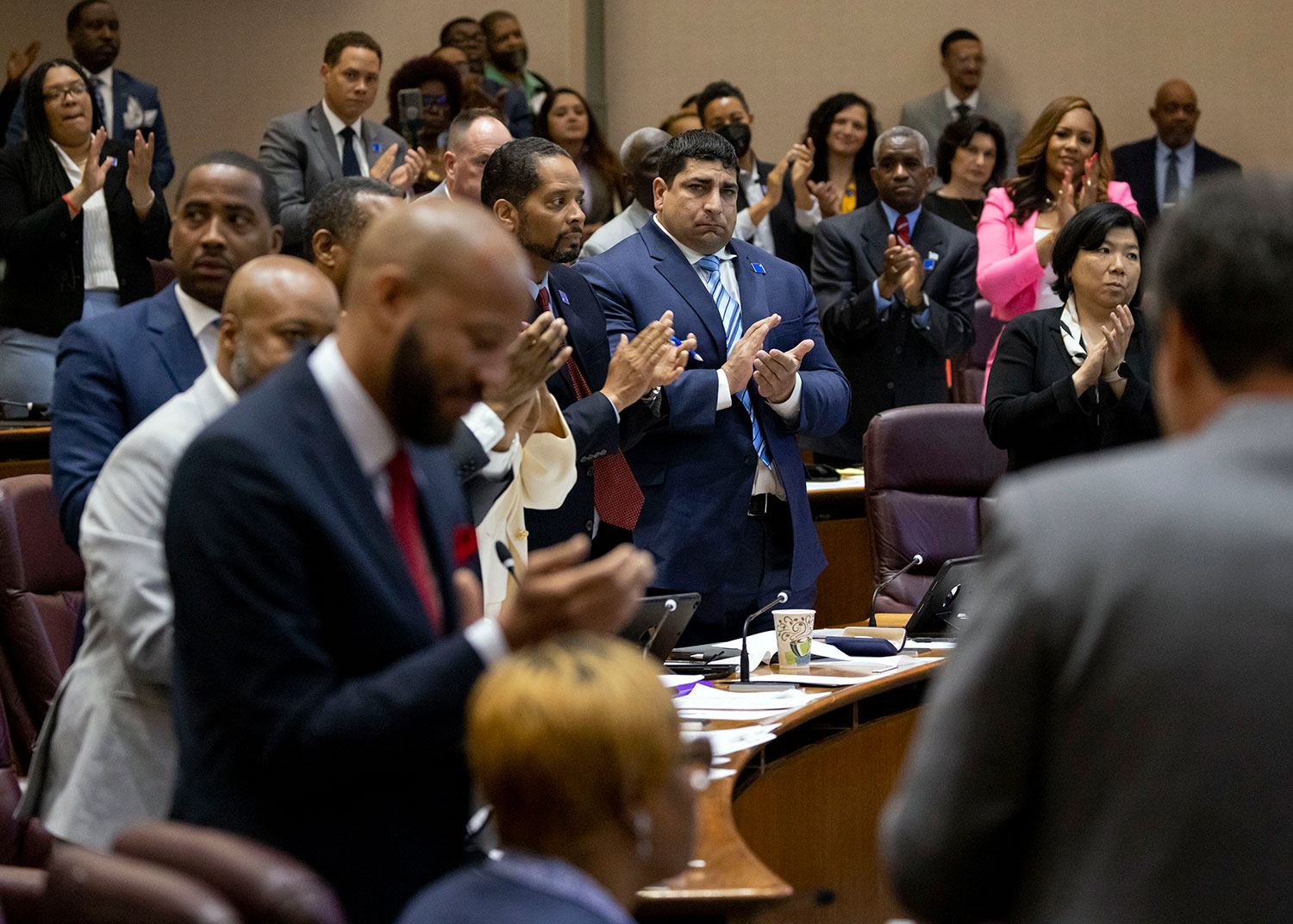“This is the most diverse City Council in Chicago history,” 2nd Ward Ald. Brian Hopkins announced at the May 24 Council meeting, the first for alders elected this year.
After the Council approved its committee appointments, Mayor Brandon Johnson declared it “the most diverse group of Council chairs in Chicago history, to ensure the diversity of our city is reflected: seven Latinx chairs, the first Latina chairwoman.”
Ald. Pat Dowell is “the first woman Finance Committee chair,” Ald. Walter Burnett “the first Black vice mayor,” Johnson said. The mayor apologized to Ald. Samantha Nugent, the new president pro tem and a white woman, “for not having a historical designation for you.”
Overall, the City Council is composed of 20 Black, 14 white, 14 Latino and two Asian alders. (During the ward remapping, the Black caucus battled to preserve its representation, even though Black population loss has reduced the community to a third-place ethnic group in the city. The Council lost a Black majority ward, when the 34th was moved from the Far South Side to the West Loop. However, three Black alders represent North Side wards where Blacks are in the minority: Angela Clay in the 46th, Matt Martin in the 47th, and Maria Hadden in the 49th.) Nine alders are openly LGBTQ+, more than any other City Council in the nation. This Council could not be any more representative of Chicago’s ethnic diversity if its members were chosen by lottery. (With 32 male and 18 female alders, the Council has not yet achieved gender equity, but it’s doing better than the U.S. Congress, which is 29 percent female.)
To see how far we’ve come, let’s look at how much the Council has changed during the lifetime of its members. The average age of an alder is 47 years old. In 1976, there were only three women on the City Council, no Latinos, no openly LGBTQ+ members, even though Illinois was the first state to repeal its sodomy law in 1961. Diversity meant putting an Irishman, a Pole, an Italian and a Jew on the same committee. A handful of Black alders represented the South and West sides, but the Council was dominated by men named Shannon, Joyce, Oberman, Adduci, Kwak, Stemberk, Zydlo, Roti, Vrdolyak, Bilandic, Burke, Marzullo, Fifelski, Gabinski, Lipinski, Pucinski, Wilinski, Hagopian, and Laurino. In the 1970 Census, whites constituted 60 percent of Chicago’s population, Blacks 32 percent. Chicago was run by white ethnic politicians, under the command of Richard J. Daley, whose Regular Democratic Organization controlled 48 of the Council’s 50 seats. The Chicago Tribune called the previous year’s elections a “crushing win at the polls for Daley.” The newspaper seemed only concerned that Republicans were left out of power, since Daley defeated the last GOP alderman.
Back then, white ethnics dominated Chicago, politically and culturally. In his 1983 eulogy for George Halas, Mike Royko called the Bears owner a “classic Chicagoan,” because “like most of us, he was an ethnic” — a term used for working class second- or third-generation Americans with ancestors from Poland, Ireland, Italy, Greece, Bohemia, or Russia. If most of Chicago was ethnic in 1983, it isn’t now. On the 1976 City Council roster, I counted 10 Polish names. On this year’s roster, I count zero. When 10th Ward Ald. Susan Sadlowski-Garza retired, she was succeeded by Peter Chico, a member of a prominent Mexican-American political family. (The 10th Ward was once represented by Edward Vrdolyak, a Croatian who led the white ethnic opposition to Mayor Harold Washington. It is now 80 percent Latino.) Poles have disappeared from Chicago politics because “90 percent of Poles live in the suburbs,” says Dominic Pacyga, author of American Warsaw: The Rise, Fall and Rebirth of Polish Chicago. When Poles moved out of Brighton Park, Archer Heights, and Avondale, Latinos moved in and claimed the City Council seats. Ed Burke hung on in the 14th Ward through 54 years of white flight because he did so many favors for so many constituents. Burke finally retired this year. His successor: Jeylu Gutierrez.
As Michael Barone wrote in the Washington Examiner, white ethnics are “a waning percentage of Chicago voters.” They’ve waned so much they couldn’t even elect Paul Vallas, one of their own, as mayor.
The white ethnics who haven’t fled to the suburbs are those who can’t: cops, firefighters, water department supervisors. City workers have moved as close to the suburbs as they can get, clustering in Norwood Park, Edison Park, Clearing, Beverly, and Mount Greenwood, neighborhoods represented by Irish and Italian alders who would have fit in on Mayor Daley’s City Council: Nicholas Sposato, Anthony Napolitano, and James Gardiner on the Northwest Side, Marty Quinn and Matt O’Shea on the Southwest Side. The remaining white alders are in gentry wards near the lakefront. The new 34th Ward just elected Bill Conway, whose father is a billionaire financier. Conway’s election was the only gain for white representation, since he took the place of Ald. Carrie Austin. whites are now underrepresented on the Council, since they’re 33 percent of the city’s population, but hold only 28 percent of the seats. That shouldn’t bother white people. When whites dominated the City Council, they represented immigrant groups struggling for the jobs and power that would allow them to join the American mainstream. Now those groups have jobs, have power, and are the mainstream. It’s time to give someone else a leg up.



